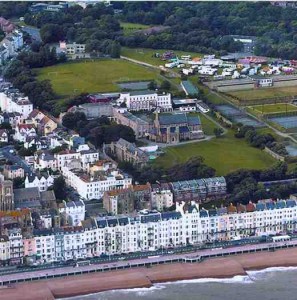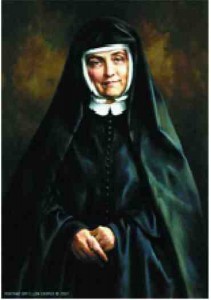The Old Convent

Aerial view of the Magdalen Road convent site. In the background, the funfair on the Oval may be seen.
The origins and history of the Magdalen Road convent by Bohemia resident Bernard McGinley
South of Bohemia Road and west of the Oval is the Convent site. The Convent’s existence is largely the work of one woman, Cornelia Connelly, née Peacock in Philadelphia in 1809. From a rich Presbyterian/Episcopalian background, she married Pierce Connelly and had many children. (A slave was a present for the eldest, born in Mississippi in 1832.) Her husband soon decided that Roman Catholicism was the way of the future. Rapidly in every sense they went over to Rome: he became a priest and she became a nun.
Well-connected in British Society, she was encouraged to set up her own order of nuns. She founded the Society of the Holy Child Jesus (SHCJ), modelled on the Jesuits, and in 1848 she and her 17 followers arrived by train to set up their headquarters. The nearest station was Bo-Peep Junction. All Souls Convent, situated on the then-isolated stretch of land between St Leonards and Hastings, was the first Roman Catholic female institution in England since Henry VIII’s break with the Papacy in the 1530s.
In the years following the Catholic Emancipation Act of 1829, a local priest, Revd John Jones, was active. With a view to founding a charity, he bought this land from the Eversfield Estate, using a bequest from Lady Stanley, a Roman Catholic benefactor married to Sir William Stanley, 5th Baronet, of Hooton and Stourton. Revd Jones’s emphasis on ‘conventual property’ is well recorded. The elegant and only building touching the east pavement of Magdalen Road still carries the date ‘1840’. The whole 15-acre site was soon offered to the incipient SHCJ, who accepted and made it their mother-house.
When Revd Jones died soon after, the entire property was left to Lt Colonel Charles Towneley, a nephew of Lady Stanley. As an MP and magistrate he had access to top legal advice, and he established a trust deed (with trustees) for the Convent, to achieve ‘the safest mode of settling the property for the objects of an Educational Religious Community’.
Questions of the use of the resources, public access to worship, and who was ultimately in charge, led to a discreet power struggle. Towneley was a generous supporter of Mother Connelly and the SHCJ. In opposition, others worked for Cardinal Wiseman and his followers, who emphasised ‘the mission’ of faith and conversion, and believed that the English Counter-Reformation could finally be achieved. Revenues and expenses (as well as workloads and prestige, and views of religious activity) were in dispute. As late as 1864, eviction seemed possible. In grim times, the SHCJ did poor relief in St Leonards and Ore. By 1856 the Convent site had a Poor School, a Middle School, a Highest School, and a Teacher-Training College – all partly residential. The Holy Child Theatre did plays in continental languages. In addition to academic subjects, girls were taught needlework, dancing (the polka and the waltz) and sea-bathing. About this last, one senior churchman countered by suggesting that salt be added to the bathwater. But Cornelia Connelly’s vision of a rounded education looks farsighted today. Her solidly educational Book of the Order of Studies was published on the Convent’s own printing press.
Meanwhile, Pierce Connelly’s strange behaviour grew to become intensely anti-Catholic, and led to the scandalous case of Connelly v Connelly – in which he petitioned Parliament and the Vatican. Even while fighting child-custody battles with her ex-husband, ‘the Foundress’ had a deteriorating relationship with Cardinal Wiseman and his staff. (The establishment in 1865 of St Thomas’s church, Magdalen Road, arose from the latter intricate dispute.) Despite various setbacks, the SHCJ order worked hard and expanded.
The Gothic Revival chapel at the Convent was completed in 1868 by E W Pugin, son of the more celebrated A W Pugin, co-designer the Houses of Parliament. Most of the Convent, including its other chapel, was the work of W W Wardell. This other chapel was also used as a refectory and community room, indicating the busy community that flourished in this complex of buildings. The Foundress died in 1879, and is now a candidate for sainthood. Eventually the mother-house of the order was moved to Mayfield, East Sussex, where the nuns had founded a school and sanatorium in 1863. Following curricular changes, in 1976 the sisters of the SHCJ sold the St Leonards site, but continue their educational ministry: the nuns have long had an active presence in four continents, where Cornelia Connelly’s name is very well known.
After some years as a summer-school for continental teenagers, change possibly pends for the old Convent. Though all of the site is in a Conservation Area, developers are encroaching. Blocks of flats and hundreds of parking spaces are now proposed.
A better use is imaginable. Bernard McGinley



Hi was this convent ever used as a children’s home or a home for disturbed children back in the 1960s